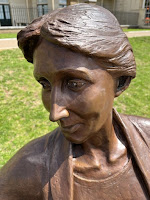Illustration by Sophie Kuang and Antonio Perricone for an article
written by Cara Nicholson in The Isis Magazine (2019): click here.
What is ASMR?
In brief: an autonomous sensory meridian response is a queer tingling
sensation that often begins on the scalp and moves down the back of
the neck and upper spine.
Some commentators have described it as a pleasant form of paresthesia, though I suppose that depends on what (or who) triggers the feeling and upon the individual experiencing it; euphoria to one person is simply irritating to another.
ASMR is most commonly triggered by auditory and/or visual stimuli, rather than the direct touch of another. And so might best be conceived, like masturbation, as a mental rather than a physical phenomenon.
Orgasm, however, isn't always the desired outcome; some are seeking relaxation rather than sexual gratification and Jennifer Allen who, in 2010, coined the phrase autonomous sensory meridian response, purposely selected these clinical-sounding terms to cover a wide field of experience [1].
Having said that, pornographic ASMR that is deliberately designed to erotically stimulate is certainly available and technosexuals who enjoy getting their tingles in this manner can do so with the help of a vast array of online videos and social media livestreams.
Finally, it might be noted, that whilst ASMR is certainly a real phenomenon, little scientific research has been conducted into it [2]. Thus, there's scant neuropsychophysiological data available at this time and this does make one rather skeptical of the claims made by some evangelical proponents who think that, like meditation and yoga, it has all kind of miraculous health benefits.
Personally, I like to hear a woman whisper in a sexy voice or watch her apply her make-up as much as the next man, but I'm not convinced this is therapeutic - that it will, for example, assuage my anxiety, dispel my depression, or cure my insomnia. What's more, I suspect that many who claim they experience euphoria at the drop of a hat are simply kidding themselves.
Notes
[1] It might reasonably be argued that this is simply a new name for an old thing. The Austrian writer Clemens Setz reminds us, for example, of the following passage in Mrs Dalloway (1925) in which a nursemaid speaks to her shell-shocked male patient, Septimus:
"'K … R …' said the nursemaid, and Septimus heard her say 'Kay Arr' close to his ear, deeply, softly, like a mellow organ, but with a roughness in her voice like a grasshopper's, which rasped his spine deliciously and sent running up into his brain waves of sound which, concussing, broke. A marvellous discovery indeed - that the human voice in certain atmospheric conditions (for one must be scientific, above all scientific) can quicken trees into life!"
Does this qualify Virginia Woolf as an ASMRtist? Arguably. Though what poet doesn't understand the power of the human voice? What musician doesn't appreciate the power of sound? What painter worth their salt doesn't know how to trigger a response from the viewer via visual stimuli?
Readers of German might like to see the article by Setz entitled 'High durch sich räuspernde Menschen', in Süddeutsche Zeitung, (6 April 2015): click here. See too the article by Cara Nicholson on Woolf and ASMR in The Isis Magazine that I link to beneath the lovely illustration by Sophie Kuang and Antonio Perricone at the top of this post.
The passage in Mrs Dalloway is in Part 1: Early Morning - 11.00 a.m.
[2] Writing in a post published in March 2012 on his blog Neurologica, the academic clinical neurologist Steven Novella discussed the question of whether ASMR is a real phenomenon. Whilst inclined to think it was, he also said that a lot more scientific investigation was needed before it can be conclusively accepted as such:
"It is plausible that a subset of the population has a particular pattern of neural hard wiring so that when they experience certain things that are typically quietly satisfying they get a little extra shot to their pleasure center. Once they experience this then they seek out greater and greater triggers of this response, and perhaps then a learning or conditioning component kicks in.
[But] what we need at this point are functional MRI and transcranial magnetic stimulation studies that look at what is happening in the brains of people while experiencing ASMR ..."
To read the post in full, click here.
This post is for Meni in the hope she won't find it as irritating as she does the tingling sensation of ASMR

.jpg)




